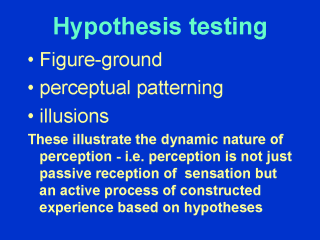| front |1 |2 |3 |4 |5 |6 |7 |8 |9 |10 |11 |12 |13 |14 |15 |16 |review |
 |
Certain characteristics of
perception strongly suggest that the pattern detection system involved is a central
feature of the process. It is important to remember that stimuli themselves carry no meaning. They may, however, acquire a signaling role, through association with certain contingencies. The organism has a strong capacity and incentive to learn such associations (which can be more or less accurate). Through this process, abstract “flags” become attached to particular stimuli, which through repetition, come to be synonymous with the stimuli. When this happens, the stimuli have acquired “meaning”; that is, they serve some informational role. Thereafter, the flags can be manipulated (either in our heads, on paper or in computers) to model and predict outcomes. At its most basic, this is the capacity of foresight. Words and other symbols are examples of such flags. Eventually, we do not respond to the physical nature of stimuli, but to the symbolic associations, the flags, that re-present particular stimulus contigencies. Complexes of stimulus contingencies can be built up enabling complex perceptual modeling. The perceptual system then can “look for” particular complex patterns in the stimulus configurations that are constantly occurring. To detect these, a process known as hypothesis-testing occurs. Whenever the perceptual system gets a close “fit” to a particular known stimulus pattern, it fills-in the missing pieces to create the experience of the whole event, much as your web browser completes the URL you type into the browser’s address line if you’ve used the address previously. Examples of this hypothesis testing can offer partial explanations for effects such as illusions, perspective, and figure-ground phenomena. |